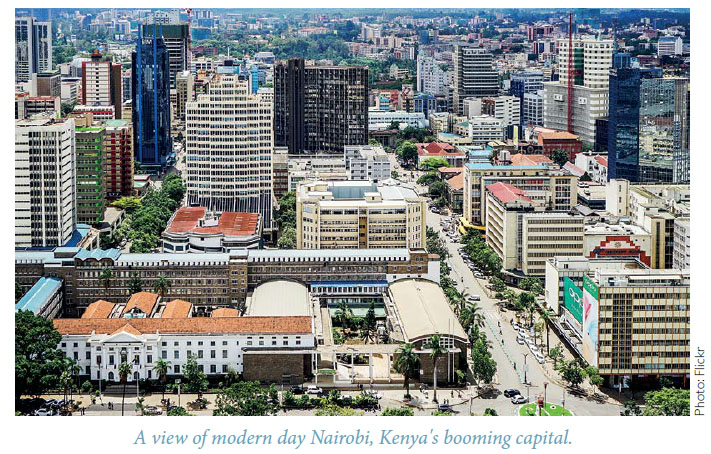 James Macharia is Cabinet Secretary of the Ministry of Transport, Infrastructure, Housing, Urban Development, and Public Works of Kenya. You may follow him on Twitter @JamesMacharia_.
James Macharia is Cabinet Secretary of the Ministry of Transport, Infrastructure, Housing, Urban Development, and Public Works of Kenya. You may follow him on Twitter @JamesMacharia_.
Since it attained independence in 1963, Kenya has been at the forefront of sustainable development efforts not only within its borders but across East Africa and the African continent. This is due to the realization that whist striving to fulfill the needs and aspirations of the current generation, we must also protect the environment and guarantee the ability of future generations to meet their needs.
The Kenyan government’s overriding objective is to avail to all of its citizens the opportunity to live a high quality of life within a clean and secure environment—as envisioned in the country’s primary development blueprint, the Kenya Vision 2030. In pursuit of this objective, the government has placed great emphasis on achieving the Millennium Development Goals (MDGs) and made substantial progress towards the achievement of these goals. Significant strides have been made in attaining universal primary education, reducing infant mortality, improving maternal healthcare, decreasing the prevalence of HIV/AIDS, and reducing extreme poverty.
In September 2015, world leaders adopted the UN Agenda 2030 for Sustainable Development. This incorporated goals to end poverty, reduce inequality, improve healthcare, protect the environment, and promote peace and justice. This was to be achieved through the development of strong institutions and the implementation of other policy initiatives by 2030. To measure progress, 17 Sustainable Development Goals (SDGs) were created, each with specific targets to be achieved within the same timelines. These 17 SDGs build on the successes of the MDGs and incorporate the lessons leant therefrom.
The SDGs set specific targets to address the global challenges we face, including those related to poverty, inequality, climate, environmental degradation, and peace and justice. All these have been identified by the government of Kenya as areas that need attention and resolution. Our country continues to experience elevated rates of poverty and inequality, societal challenges that threaten social stability.
In the recent past, the country has also experienced extreme and unpredictable weather, which most scientists attribute to global warming. This has had a detrimental effect on agricultural output, which has in turn had major knock-on effects on the overall economy as agriculture constitutes a significant 25 percent of the economy. As a result, environmental matters have been brought to the forefront of public discourse and government policy in Kenya.
The Big 4 Agenda
Following his re-election towards the end of 2017, the President of Kenya, His Excellency Honorable Uhuru Kenyatta, unveiled The Big 4 Development Agenda, which specifies four areas that his administration will focus on during the second term of his presidency (2017- 2022). The Big 4 Agenda prioritizes key basic needs that are critical to uplifting the standard of living of Kenyans and putting the country on the path to becoming an upper middle-income country by 2030. These four basic needs are the need for adequate nutritious food, affordable housing, employment, and affordable healthcare.
The Big 4 Agenda is thus enumerated as enhancing manufacturing, achieving universal health coverage, food security and nutrition, and increasing the supply of affordable housing. All these are consistent with the SDGs of achieving zero poverty and hunger, fostering good health and wellbeing, and promoting decent work and economic growth. It is also important to note that the Big 4 Agenda items are interconnected in that addressing the underlying factors necessary to achieve each of the individual Agenda goals will indirectly lead to the achievement of the other Agenda items.
The manufacturing sector has played a decisive role in most countries that have transitioned from poor to middle-income and rich countries. We expect the manufacturing industry in Kenya to be a crucial contributor to achieving high and sustainable economic growth rates, and in facilitating job creation and poverty alleviation. The government of Kenya aims to increase the contribution of manufacturing to the Kenyan economy from 9.2 percent in 2017 to at least 20 percent in 2022. Amongst the sectors that are expected to drive this growth are the textile and leather sectors, fish and agro-processing, oil, mining and gas, iron & steel, the construction industry, and the information and communications technology (ICT) sector.
For Kenyan manufacturers to thrive in an open and global economy, they must be able to produce world-class products at a competitive cost. To facilitate this, the government of Kenya continues to invest in high quality infrastructure with the aim of enhancing efficiency and reducing the cost of doing business. This is particularly critical as Kenya neighbors five landlocked countries whose principal routes of exports and imports are through the port of Mombasa at the coast with the Indian Ocean. Uganda, Rwanda, Burundi, South Sudan, Ethiopia, and the eastern part of the Democratic Republic of Congo route their imports and exports thorough Kenya. The quality of Kenya’s infrastructure, widely regarded as one of the best in sub-Saharan Africa, therefore has a significant knock-on effect on the regional economy.








